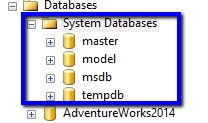SQL Server has 5 system databases:
You can see these databases under “System Databases” in the management studio.

It’s a read-only database containing all system objects. It is often referred to as a “resource” database, its actual name is “mssqlsystemresource”. You don’t see the “resource” database in SSMS’s object explorer window, but system objects persisted in the resource database logically appear in every database on the server.
In order to find out the actual location of the resource database, we can use this query:

In more outdated SQL Server versions, the Resource database is required to exclude or drop and rebuild the system entities while elevating. Nevertheless, in the more recent versions, the system entities can be moved by replicating the resource file (as it includes all these entities). In SQL Server 2000 and earlier interpretations, the resource database was not present. It is launched in SQL Server 2005 and, thus, allows upgrading more explicit and rapid.
The master database contains instance-wise metadata about the SQL server, also information about all databases installed on the current instance. It’s suggested that we should not directly access or modify the master database because if something goes wrong it will corrupt the entire SQL server.
It’s better to use catalog views in case of accessing information regarding the server configuration and status information.
It’s also important to back up the master database at various times. It is basically used to store information of all databases within SQL Server and the server cannot start if the master database is not configured properly.
It is advised to have a new backup of the master database. Specifically, it is essential to complete the master database’s backup when we develop, drop, or change new databases, logon accounts, and update configuration parameters. Also, if we have developed user objects in the master database, it is useful to tie up the master database as per the modifications of these user-created entities. It is not viable to bring a differential backup of the master database.
This database is used as the template from which the newly created database is essentially cloned. Normally we don’t change this database unless we are having a specific purpose, and most importantly we are extremely knowledgeable about potential implications.
The model database can also be utilized to construct a predefined template for a fresh database. For example, if it is instructed to have several unique entities in the all-unique database, these entities can be just inserted into the model database, rather than forming them occasionally after a recent database design. In these events, it is advised to have a backup of the model database to patch the altered rendition of the model database in case of database topics.
This database stores system settings and configurations information for various support services, such as database backups, DTS packages, Replication, SQL Server agent information, SQL Server Jobs, Database Mails, etc.
If we need to access this database, it is suggested to use its views and stored procedures.
SQL Server cannot run for an extended-term without an MSDB database. As such, it cannot be deleted or dropped, moved offline, or disconnected. Also, there is no point in dropping the MSDB database other than to instantly patch it which would be managed with a restore utilizing the REPLACE alternative.
For the past many years, MSDB has reached some various modifications between primary versions of SQL Server. For example, the “compressed_backup_size” field was used to document the volume of a database backup file. The objects required to save SSIS packages were inserted in 2005 and DTS package repository entities were later removed completely.
This database is used to store global and local temporary tables and temporary stored procedures. The tempdb database is recreated from scratch every time we restart SQL Server.
It’s highly recommended that we should use the system-provided stored procedures and catalog views to modify system objects and system metadata, and let SQL Server manage the system database. We should not change the structure of system databases through T-SQL query, and in case we needed to make some changes use system stored procedures and functions.
When a SQL Server instance is created, a unique tempdb database is built. Thus, the instance commencement date and duration and the tempdb outcome date and time are exact. So, if we wish to understand when the instance was last activated, we can simply inspect the tempdb database design date. The TempDB database is one of the most significant system databases, that is utilized to keep momentary user entities, such as the temporary tables that are specified by the user or yielded from table-valued process implementation, transient stored functions, table variables, or indexes. Standard is developed for small companies. It helps the e-commerce and data warehousing requirements of various businesses. The MSSQL database is extremely easy to install and can be managed by using various simple resources already provided by Microsoft.
MS SQL handles data warehouse via its root element, which is, SQL Server Database Engine. Safety, processing, and repository of data reach beneath the server. The Database Engine can manage directions and queries. It can handle transactions and other important things. The SQL Server is typically utilized by extensive organizations.